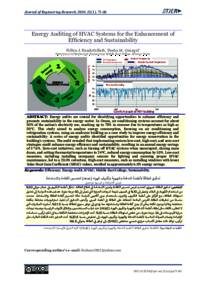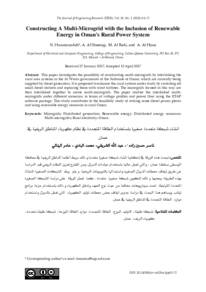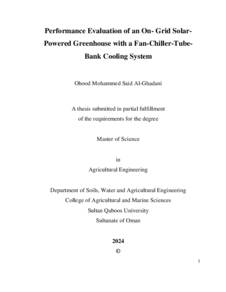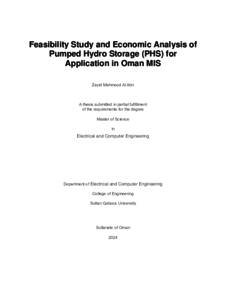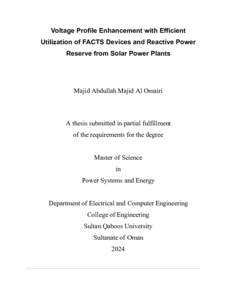Document
Energy auditing of HVAC systems for the enhancement of efficiency and sustainability.
Identifier
DOI:10.53540/tjer.vol.21iss1pp71-86
Source
Journal of Engineering Research, v. 21, no. 1, p. 71-86.
Contributors
Guangul, Fiseha M., Author
Other titles
تدقيق الطاقة لأنظمة التدفئة والتهوية وتكييف الهواء لتحسين الكفاءة والاستدامة.
Country
Oman
City
Muscat
Publisher
Sultan Qaboos University.
Gregorian
2024-08-14
Language
English
Subject
English abstract
Energy audits are crucial for identifying opportunities to enhance efficiency and
promote sustainability in the energy sector. In Oman, air conditioning systems account for about
50% of the nation's electricity use, reaching up to 70% in summer due to temperatures as high as
50°C. This study aimed to analyze energy consumption, focusing on air conditioning and
refrigeration systems, using an academic building as a case study to improve energy efficiency and
sustainability. A series of energy audits identified opportunities for energy conservation in the
building's systems. The audit revealed that implementing various low-cost, high-cost, and zero-cost
strategies could enhance energy efficiency and sustainability, resulting in an annual energy savings
of 37.6%. Zero-cost initiatives, such as turning off HVAC systems when unoccupied, closing main
doors, and setting thermostat temperatures to 24ºC, reduced energy consumption by 10%. Low-cost
measures, including installing occupancy sensors for lighting and ensuring proper HVAC
maintenance, led to a 20.8% reduction. High-cost measures, such as installing windows with lower
Solar Heat Gain Coefficient (SHGC) values, resulted in approximately 6.8% energy savings.
ISSN
Online: 1726-6742
Print: 1726-6009
Arabic abstract
تدقيق الطاقة ضروري لتحديد فرص تحسين الكفاءة وتعزيز الاستدامة في قطاع الطاقة. تشكل أنظمة التكييف في عمان حوالي 50٪ من استخدام الكهرباء في البلاد، وتصل إلى 70٪ في الصيف نتيجة لدرجات الحرارة التي تصل إلى 50 درجة مئوية. هدفت هذه الدراسة إلى تحليل استهلاك الطاقة، مع التركيز على أنظمة التكييف والتبريد باستخدام مبنى أكاديمي كحالة دراسية لتحسين كفاءة الطاقة والاستدامة. كشفت عمليات تدقيق الطاقة عن فرص لتوفير الطاقة للمحافظة على أنظمة المبنى. وأظهرت النتائج أن تنفيذ استراتيجيات مختلفة بتكلفة منخفضة وعالية ودون تكلفة يمكن أن يعزز كفاءة الطاقة واستدامتها، مما يؤدي إلى توفير سنوي للطاقة بنسبة 37.6٪.
أشارت المبادرات التي لا تتطلب تكلفة مثل إطفاء أنظمة التدفئة والتهوية وتكييف الهواء (HVAC) عند غياب المستخدمين، وإغلاق الأبواب الرئيسية، وضبط درجات حرارة الترموستات إلى 24 درجة مئوية، إلى خفض استهلاك الطاقة بنسبة 10٪. أدت الإجراءات منخفضة التكلفة، مثل تركيب حساسات الحركة وضمان الصيانة المناسبة لأنظمة التدفئة والتهوية وتكييف الهواء، إلى تخفيض بنسبة 20.8٪. أما التدابير ذات التكلفة العالية، مثل تركيب نوافذ ذات معامل اكتساب حراري منخفض مخصص (SHGC)، فقد وفرت الطاقة بنسبة حوالي 6.8٪.
أشارت المبادرات التي لا تتطلب تكلفة مثل إطفاء أنظمة التدفئة والتهوية وتكييف الهواء (HVAC) عند غياب المستخدمين، وإغلاق الأبواب الرئيسية، وضبط درجات حرارة الترموستات إلى 24 درجة مئوية، إلى خفض استهلاك الطاقة بنسبة 10٪. أدت الإجراءات منخفضة التكلفة، مثل تركيب حساسات الحركة وضمان الصيانة المناسبة لأنظمة التدفئة والتهوية وتكييف الهواء، إلى تخفيض بنسبة 20.8٪. أما التدابير ذات التكلفة العالية، مثل تركيب نوافذ ذات معامل اكتساب حراري منخفض مخصص (SHGC)، فقد وفرت الطاقة بنسبة حوالي 6.8٪.
Category
Journal articles

